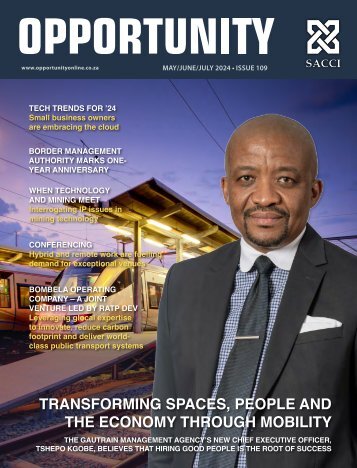South African Business 2016 edition
- Text
- Investment
- Government
- Business
- Development
- Network
- Sectors
- Investing
- Business
- Africa
- African
- Economic
- Manufacturing
- Mining
- Opportunities
- Economy
- Overview
OVERVIEW Transport
OVERVIEW Transport South Africa is spending heavily on transport infrastructure. Economic Development Minister Ebrahim Patel has announced 17 major Strategic Infrastructure Projects in a variety of sectors. Transport is among the most important of these. Transnet is the state-owned transport and logistics company responsible for most of South Africa’s rail network, rail freight, ports, port terminals and South Africa’s fuel and gas pipelines. It will spend R300-billion across its five divisions in the period to 2019. In terms of the national Public Transport Strategy, priority rail corridors and bus rapid transit (BRT) systems are being introduced in all of the country’s major cities. The Maputo Development Corridor is Africa’s most advanced spatial development initiative. Run by the Maputo Development Corridor Logistics Initiative (MCLI), the corridor runs from just outside Pretoria in Gauteng, to Maputo in Mozambique. The Harrismith Logistics Hub (HLH) on the N3 is intended as an inland port that can handle cargo containers and shift cargo from road to rail, reducing congestion and costs. The volume of cargo passing through Harrismith is expected to increase by 25% per annum for the next seven years. South Africa’s ports are covered in the maritime section of this publication. Rail Grain tonnages carried by Transnet Freight Rail (TFR) will almost double in the years to 2019. The assets of TFR’s new Container and Automotive Business (CAB) unit have been ring-fenced. The CAB has been created because of the importance of the Johannesburg-Durban line. TFR has a 20 953km network – about 80% of African infrastructure – with the potential to transport huge volumes. Transnet Freight Rail intends to increase the amount of freight it carries from 200-million tons to 300-million tons. A new line to carry coal from the inland to the coast through Swaziland is being investigated. Some private companies such as Rail Road Logistics Grindrod and Sheltam operate rail systems in the gold-producing areas of the Free State and Gauteng. At the National Assembly Committee address in March of this year, the Department of Transport & Passenger Rail Agency of South Africa addressed challenges related to the rail & road netowrk systems. Lucky Montana, CEO of PRASA, said PRASA focused on public transport and the National Development Plan (NDP). It was the implementing arm of the National Department of Transport, providing transport via road and railway. As a government entity, the initiatives for PRASA were driven by policies and transport strategy. The rail sector took up 80% of the business of PRASA, mainly through Metrorail. They had a few bus services, including Translux and City to City. They also had a property division. He provided statistics highlighting the work of PRASA. It had 22 300km of rail network, 4 638 metro coaches, 550 million trips a year for Metrorail passengers, 16 500 employees, 589 stations, and assets of R36 billion. The biggest challenges for PRASA were its old and dilapidated railway infrastructure, long queues, overcrowding and unreliable trains. People could lose their bread and butter if they were late for job opportunities because of late trains. Line, train and signal capacity were limited. Most of SOUTH AFRICAN BUSINESS 2016 106
OVERVIEW 107 SOUTH AFRICAN BUSINESS 2016
- Page 1:
SOUTH AFRICAN BUSINESS 2016 EDITION
- Page 6:
CONTENTS Introduction CONTENTS Sout
- Page 10 and 11:
CREDITS Publisher Chris Whales Publ
- Page 12 and 13:
SPECIAL FEATURE South Africa A peri
- Page 14 and 15:
SPECIAL FEATURE In a year that saw
- Page 16 and 17:
SPECIAL FEATURE owes its existence
- Page 18 and 19:
SPECIAL FEATURE against water losse
- Page 20 and 21:
SPECIAL FEATURE Operation Phakisa h
- Page 22 and 23:
SPECIAL FEATURE late in 2014. The h
- Page 24 and 25:
SPECIAL FEATURE Understanding Afric
- Page 26 and 27:
INTERVIEW Job creation on track Ala
- Page 28 and 29:
SPECIAL FEATURE Business funding Th
- Page 30 and 31:
SPECIAL FEATURE in turn makes it ve
- Page 32 and 33:
SPECIAL FEATURE Contact: 012 394 18
- Page 34 and 35:
SPECIAL FEATURE Black Business Supp
- Page 36 and 37:
SPECIAL FEATURE The evolution of sk
- Page 38:
SPECIAL FEATURE providing TVET lear
- Page 42:
PROFILE FP&M Seta Facilitating and
- Page 45 and 46:
• The development of a national s
- Page 48 and 49:
FOCUS Champions of change Five dyna
- Page 50 and 51:
SPECIAL FEATURE The top law firms S
- Page 52 and 53:
SPECIAL FEATURE Keeping the BRICS t
- Page 54 and 55:
SPECIAL FEATURE Keeping BEPS in che
- Page 56 and 57:
SPECIAL FEATURE IPAP in action In 2
- Page 58 and 59: FOCUS THERE’S NO END TO THE BENEF
- Page 60 and 61: INTERVIEW The riches of Africa awai
- Page 62 and 63: INTERVIEW and it could actually be
- Page 64 and 65: PROFILE ECIC exco profiles Profiles
- Page 66 and 67: INTERVIEW The hub of Africa Tim Har
- Page 69 and 70: Key sectors Overview of the main ec
- Page 71 and 72: OVERVIEW from the subsistence farme
- Page 73 and 74: OVERVIEW South Africa produces abou
- Page 75 and 76: South Africa’s looming energy gap
- Page 77 and 78: How will these resources be develop
- Page 79 and 80: Vall exclusive economic zone limits
- Page 82 and 83: OVERVIEW NEED PIC Mining The South
- Page 84 and 85: OVERVIEW Mineral beneficiation The
- Page 86 and 87: PROFILE The Council for Geoscience
- Page 88 and 89: OVERVIEW Energy The South African e
- Page 90 and 91: INTERVIEW Cummins South Africa Cumm
- Page 92 and 93: OVERVIEW Manufacturing Increasing m
- Page 94 and 95: OVERVIEW Automotive International i
- Page 96 and 97: OVERVIEW Automotive components Incu
- Page 98 and 99: OVERVIEW Chemicals and pharmaceutic
- Page 100 and 101: OVERVIEW Healthcare South Africa’
- Page 102 and 103: OVERVIEW Water Severe water restric
- Page 104: OVERVIEW Improving quality The intr
- Page 107: Our Vision is is “Quality water f
- Page 111 and 112: OVERVIEW airports in India and Braz
- Page 113 and 114: affords, while maintaining its envi
- Page 115 and 116: kets, except Australia. In Africa,
- Page 117 and 118: Rosebank, Johannesburg, renamed ‘
- Page 119 and 120: Trade with Africa Improved infrastr
- Page 121 and 122: FOCUS MTN plugs R1.2-billion into K
- Page 123 and 124: MTN rolls out fibre infrastructure
- Page 125 and 126: OVERVIEW community engagement. The
- Page 127 and 128: PROFILE For BEE Verification and is
- Page 129 and 130: OVERVIEW attracting and retaining c
- Page 131 and 132: OVERVIEW Small business is taken ve
- Page 133 and 134: Franchise Fund—an innovative plat
- Page 135 and 136: educating young people in fields th
- Page 137 and 138: OVERVIEW Management Plan has divert
- Page 139 and 140: hazardous waste is also not being c
- Page 141 and 142: INTERVIEW yourself up as a Tier 1 o
- Page 144 and 145: OVERVIEW Renewable energy South Afr
- Page 146 and 147: INTERVIEW Plenty of scope for solar
- Page 148 and 149: LISTINGS South African business org
- Page 150 and 151: LISTINGS South African National Gov
- Page 152 and 153: LISTINGS Department of Communicatio
- Page 154 and 155: LISTINGS Department of Human Settle
- Page 156 and 157: LISTINGS Department of Science and
- Page 158 and 159:
OVERVIEW Regional overview: Eastern
- Page 162 and 163:
INTERVIEW Buffalo City on the rise
- Page 164 and 165:
OVERVIEW Regional overview: Free St
- Page 166 and 167:
OVERVIEW Regional overview: Gauteng
- Page 168 and 169:
FOCUS A Catalyst for Economic Devel
- Page 170 and 171:
FOCUS business people and tourists
- Page 172 and 173:
OVERVIEW Regional overview: KwaZulu
- Page 174 and 175:
OVERVIEW Regional overview: Limpopo
- Page 176 and 177:
OVERVIEW Regional overview: Mpumala
- Page 178 and 179:
The powerhouse of Africa Mpumalanga
- Page 180 and 181:
Mpumalanga: Key Sectors Mpumalanga
- Page 182 and 183:
Nkomazi Special Economic Zone The N
- Page 184 and 185:
INVEST IN THE PROVINCE OF THE RISIN
- Page 186 and 187:
OVERVIEW Regional overview: Norther
- Page 188 and 189:
OVERVIEW Regional overview: North W
- Page 190 and 191:
OVERVIEW Regional overview: Western
- Page 192 and 193:
FOCUS Khayelitsha - the power of to
- Page 194 and 195:
INDEX INDEX Abeco Tanks ...........
- Page 196:
ENSafrica.com ENSafrica | Africa’
Inappropriate
Loading...
Mail this publication
Loading...
Embed
Loading...























































































































































